Disclosure: Meeple Mountain received a free copy of this product in exchange for an honest, unbiased review. This review is not intended to be an endorsement.
It’s Time to Duel
This is it. The moment you have been waiting for. Your rigorous training has prepared you to step into the ring and meet your challenger head-on. This battle will prove that you have mastered the way of bushido and will propel you to greater heights as a warrior and martial artist. Your honor is on the line here and you cannot be defeated now, but your opponent is equally motivated. Fear and doubt begin to gnaw at the back of your mind, but you take a calming breath, center yourself, and walk into the dojo.
The Way of the Warrior
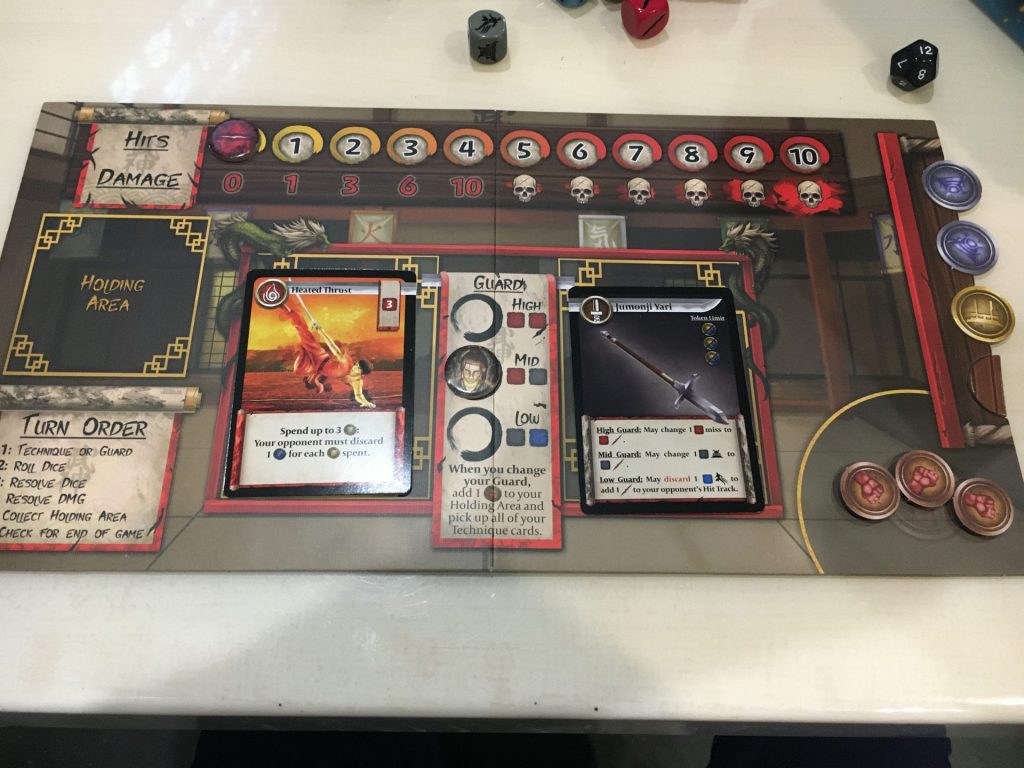
Bushido sets you in the role of a fighter training to hone their skills in combat. In this two-player game you’ll square off against your opponent in card drafting combat. Bushido is played over a series of rounds where players will draft cards, select a weapon for combat, play skill cards, and roll lots of dice to see who can come out on top. The victor is whoever defeats the other by assigning enough “hits” to render them unconscious. Each of these phases are very important in your success as a warrior so let’s explore each of them.
Bow to Your Sensei
There are 3 phases in Bushido: Training, Arming and Duel. The real meat of the game is the Duel phase where you go head-to-head against your opponent, but your success or failure there is all determined in the previous phases.
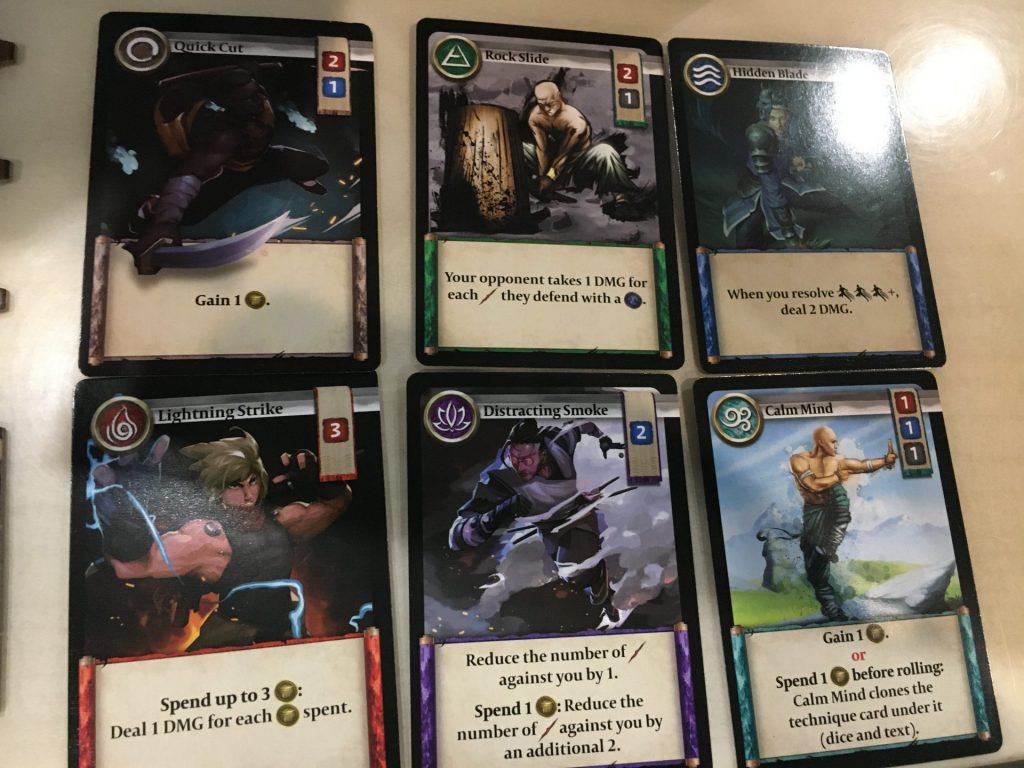
First, you begin in the Training Phase. Here you will select the skills you will use in your battle. This phase consists of 5 rounds with each player drafting 1 of 4 revealed skill cards. The 2 remaining cards are discarded and 4 more are drawn. The process repeats until each player has a hand of 5 skill cards to use in combat. These cards will empower your attacks, provide unique abilities, and create your dice pool for your attacks. Cards come from various elements and you can synergize your elements to create stronger attacks. Once you have selected your hand for this combat, you will move to arming yourself.
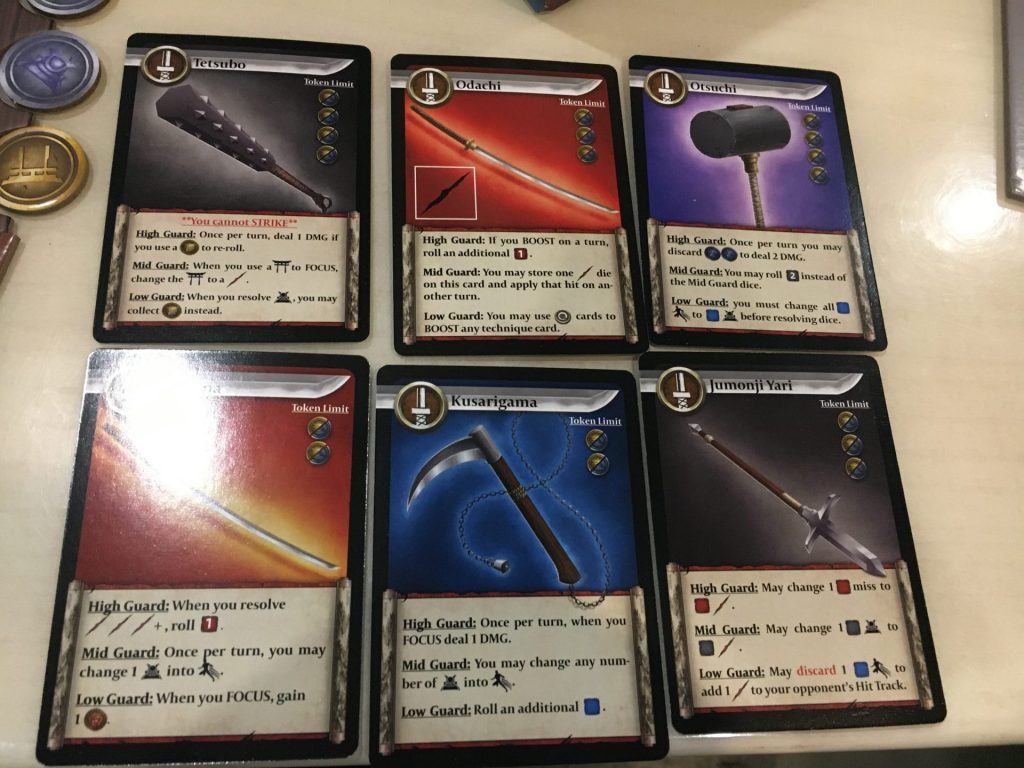
In the Arming Phase, you will secretly select 1 of the 5 weapons available to you. Each weapon will provide abilities based on which guard you choose to use as well as a “token limit” which restricts how many guard or tori tokens you can have at one time. These tokens are essentially blocks and rerolls that you can use as needed in the duel. Once both players select and reveal their weapons, they will choose their starting guard position and then move into combat.

In the Duel Phase players will take turns playing their attack cards in an attempt to deal enough hits to the other to defeat them. Play goes in a series of rounds until one player is victorious. On each turn, a player must start with 1 or 2 actions—either resolving a card from their hand or switching their guard and collecting all played cards back to their hand. There is a bit of ebb and flow here with players starting with all 5 cards in their hands, but their options dwindle as the rounds go on.

Once either of these actions are taken, a player will determine their dice pool based on their guard’s stance, as well as any cards they have played. As you can see from the photo, dice have varied results ranging from adjusting a hit track (yours or your opponent’s), gaining block or tori tokens, or a miss. Dice come in three colors with red focused on attack, and grey and blue focused on defence. When taking damage, you calculate how many hits were scored and adjust your damage track accordingly. While the hits on the hit track reset each attack, the damage you accumulate stays with you. If you ever land in a damage spot showing a skull, you have been defeated and your opponent is the victor.
The Way of the Shinobi
No warrior is complete without a few tricks up their sleeve. So let’s discuss a few technical aspects of Bushido and how cards interplay, as well as how tokens work.
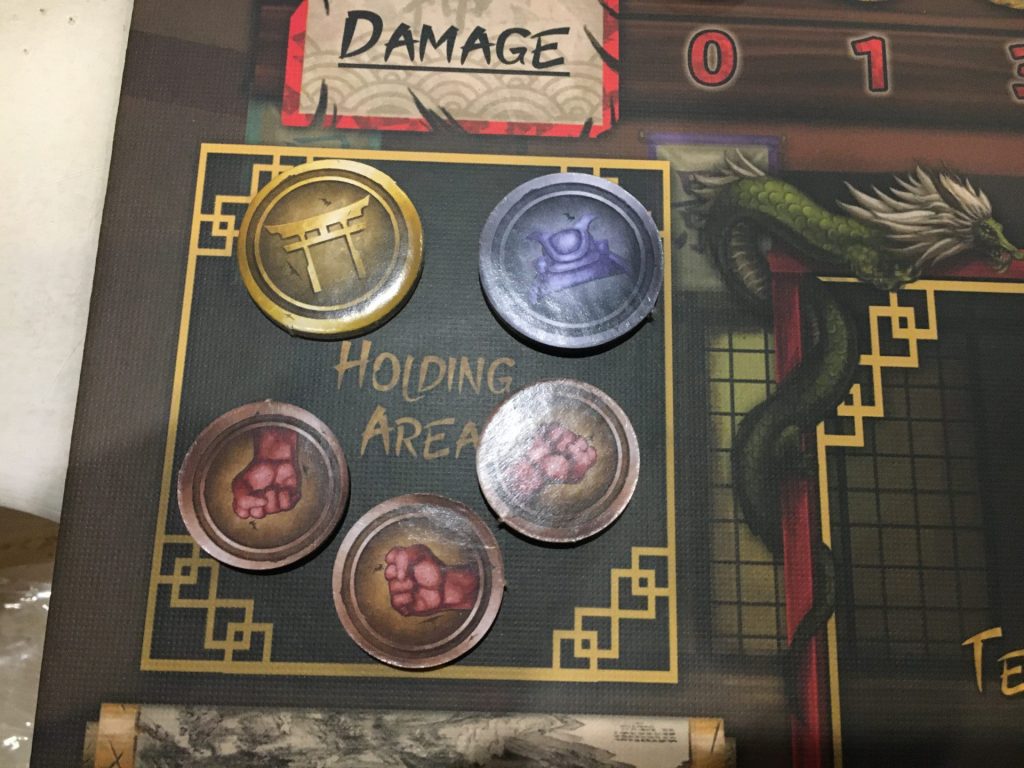
There are 3 types of tokens in Bushido: rage, tori and armor. Each are collected during turns and placed in your holding area; from there, they are collected at the end of each attack. They function in various ways outlined below.
Rage tokens are collected through cards and allow you to add a red die to your attack for each token you spend. There is no limit to the number of these tokens you can hold.
Tori tokens are only collected when they are rolled on dice and allow you to reroll blanks. These tokens apply to your token limit.
Armor tokens are also collected when they are rolled on dice and allow you to block hits that are assigned to you at a 1:1 ratio. These tokens also apply to your token limit.
Cards of matching elements can be played together to empower a card you are playing. For instance, if you played a green element card, you would get the dice from that card. If you played another green element card, you would power that attack up and gain one additional die of your choice from those depicted on the card. This creates a struggle of choosing to empower attacks and having to switch guards more often to get your cards back. The conundrum that arises here is that your attacks will vary from being quite dice heavy to very weak which has some strategy to it. The key I found was to try to prep to land a very dice heavy attack when your opponent just used or did not recoup any guard tokens.
Final Thoughts
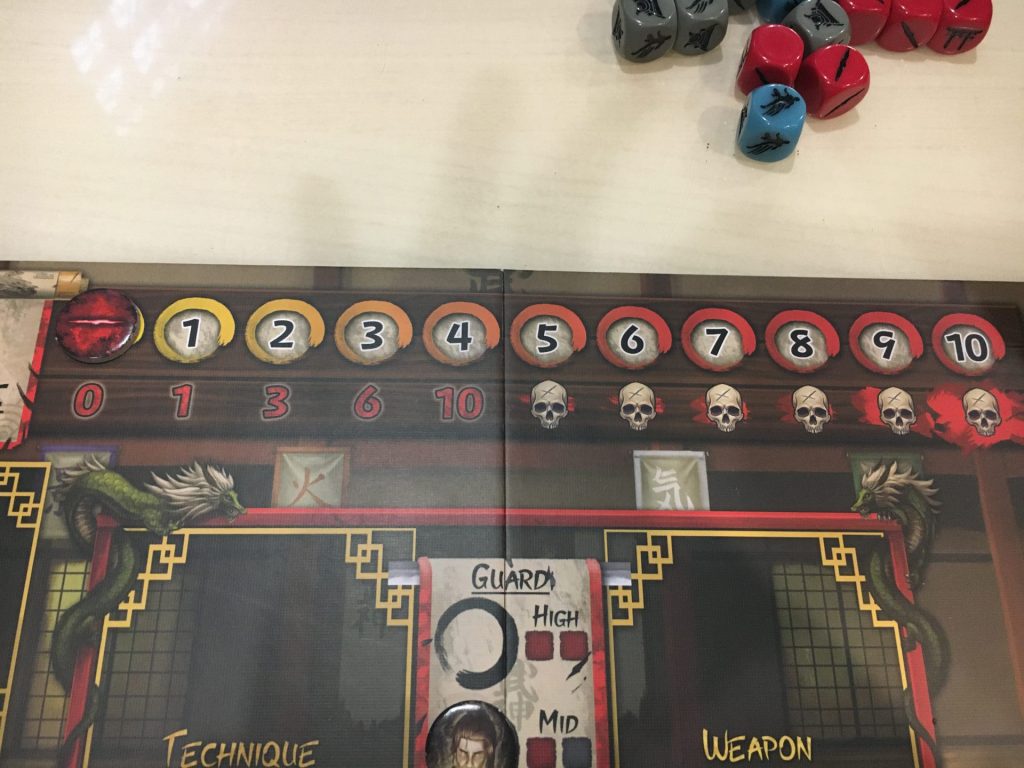
Bushido is a microbiome composed of some engine building, strategy and dice chucking. It has a unique feel and is a nice addition to the two player-centric games on the market. It can be played by 4 but Bushido is really meant for 2. If you are a connoisseur of the two-player only style games, you may start to have the “big” titles pop into your head such as Star Wars: Rebellion, War Chest, 7 Wonders Duel, Twilight Struggle and many more. Two-player exclusive titles are very difficult to craft as they have to be constantly engaging without each interaction feeling too harsh since you are always targeting the same opponent. It is so important to create a waltz of sorts between the players where the ebb and flow of the game is palpable. Bushido does a great job of this in the Duel phase.
The nice back and forth really does simulate a duel between rivals. The choices you are faced with are meaningful. How you select your cards, how you play them— empowering attacks or switching guards—and whether you specialize for blocking or offensive rerolls all matter. This layering of strategic choice gives Bushido a great sense of replayability and vibrancy that all two-player games really need. Games usually were very close and always came down to a great roll (or botched one). I kept walking away from games thinking “ohhh, now I want to try x”. When I am so into a game I am dreaming of other options, that is a huge selling point to me..
On the downside, Bushido does involve dice rolling. If you are not a fan of a bit of controlled luck, you may be upset. I was devastated when my surefire victory rolled 7 misses and I didn’t have any rerolls left. For me, though, this volatility is what makes dice rollers so fun and enjoyable. I will also note that I was not in love with the art style in Bushido. The art felt grainy and just did not pop as much as I feel it could have. This, of course, is a personal preference and in no way affected the gameplay.
If you like the martial artist theme and are looking for an accessible and quick two-player battle, Bushido may be just the ticket you need. Engaging and easy to teach, Bushido is a great addition to anyone’s collection if they love dice rolling and enjoy direct competition games.
Bushido
Genre: Dice Rolling, Card Drafting
Pros: Easy to Teach, Replayabilty, Short Time Commitment
Cons: Dice = Luck, “Dull” art
Rating: 5.5/10 Takes a swing at a lot of great mechanisms in gaming and delivers adequately on all fronts.


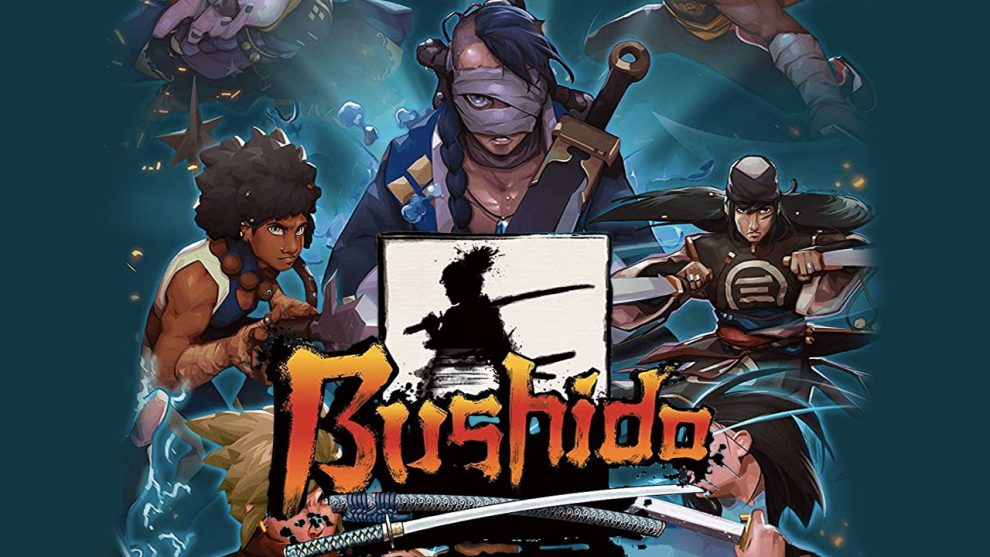








Sounds like a lot of fun! Thanks for the review. Now if I only had someone who would play this game with me…
what age group would you place this in?
Hi there! Thank you for this question. Grey Fox places this as a 14 and up game, but I believe the system is simple enough you could have a sharp 12-year-old enjoying this game in no time! The theme is rich and very engaging for a young audience.
Happy Gaming!